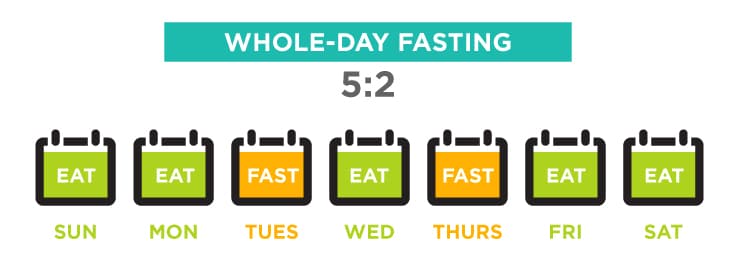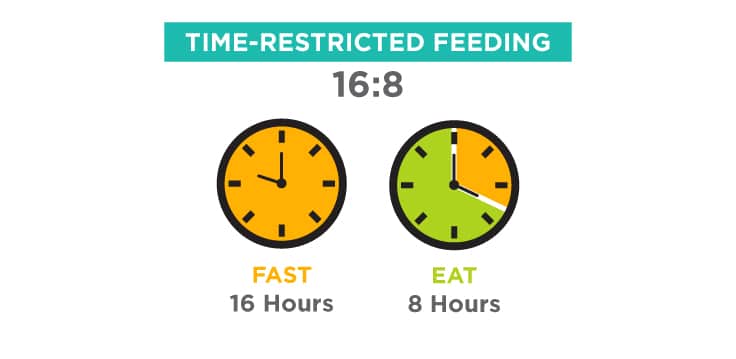One of the latest nutritional trends to catch steam in the health world is “intermittent fasting.” Simply defined, intermittent fasting (IF) is the concept of cycling between predetermined fasting and feeding times. Although IF has been around for many years, its recent rise in popularity has been a unique shift from more common dieting models that traditionally limit what you eat but not when you eat.
The recent resurgence in popularity of IF dieting likely correlates to the increase in good research coming out on the potential health benefits of intermittent caloric restriction. In fact, some studies have found that fasting can lead to reductions in oxidative damage and inflammation and can reduce obesity, hypertension, asthma, and rheumatoid arthritis.
There are many ways to go about restricting caloric intake with IF, but many people get tripped up by the terminology and scheduling. It can become quite perplexing because IF isn’t a single protocol: Many methods of time-based caloric restrictions fall under the IF philosophical umbrella. The three most popular IF classifications are:
Alternate-Day Fasting (ADF)
ADF is a method of IF in which fasting and feeding are broken up into alternating days. The most popular style of ADF is the 36:12 method. For the 36:12 method, you eat breakfast when you wake up, then consume all other meals within a 12-hour window. You then proceed to fast for 36 hours until the next feeding time. Here’s what that could look like in practice: Sunday: Eat 8 a.m. to 8 p.m.
Sunday: Eat 8 a.m. to 8 p.m.
Monday: Fast
Tuesday: Eat 8 a.m. to 8 p.m.
Wednesday: Fast
Thursday: Eat 8 a.m. to 8 p.m.
Friday: Fast
Saturday: Eat 8 a.m. to 8 p.m.
Whole-Day Fasting (WDF)
WDF is another method of IF in which certain days of the week are designated as fast days and others as feed days. The most popular form of WDF is known as the 5:2 method. In the 5:2 method, two days of the week are selected as your fasting days, while the other five are your feeding days. Which days of the week are designated as fast or feed days is up to you. For example, if you chose Tuesday and Thursday to fast, that weekly schedule would look like this:
Sunday: Eat
Monday: Eat
Tuesday: 24-hour fast
Wednesday: Eat
Thursday: 24-hour fast
Friday: Eat
Saturday: Eat
Time-Restricted Feeding (TRF)
TRF is the most popular method of IF because of its recent endorsement by many prominent celebrities. TRF consists of a set daily feeding window ranging from four to eight hours, followed by a fasting window ranging from 16 to 20 hours. The most popular method of TRF is known as the 16:8 method. This is a method of feeding in a daily eight-hour window, typically from noon to 8 p.m., and fasting for the remaining 16 hours, typically from 8 p.m. to noon.
Trying to Lose Weight? Try the 16:8 Method

If you’re looking to start IF, I highly encourage you to start with the 16:8 method. The desire to lose weight is the No. 1 reason people begin new diets. It’s important to remember that the two most important parts of any weight loss plan are adherence and sustainability. A well-structured weight loss plan is worthless if you can’t stick to it. But because the IF plan is an eating pattern, not a diet, many have found success with it.
Even if you’re not on an IF plan, you still have a daily eating pattern consisting of time spent eating and not eating. IF is just a way to tweak that pre-established pattern in your favor. Think of it like this: The time you spend between going to sleep in the evening and eating breakfast in the morning isn’t dieting, but it is a non-feeding time in your daily eating pattern.
This is why the 16:8 method of TRF is so popular. If you’ve already slept for eight hours, you’re halfway there! You simply get in the habit of restricting caloric intake in the morning before returning to a normal eating pattern at lunchtime. That slight change makes weight loss more easily attainable through caloric deficit.
The concept of weight loss itself is quite simple: Consume fewer calories than you burn, putting your body at a caloric deficit. But the actual process of losing weight is much more difficult because of hunger pains, energy loss, fatigue, food restrictions, and more. But the 16:8 method doesn’t leave you feeling like there is no light at the end of the tunnel, because you still get to eat throughout the day and you are never in a position of feeling extreme hunger or cravings, as those are not typically present early in the morning.
The research is promising and has already detailed the benefits of fasting. If weight loss is your goal, the 16:8 method is a great way to get there. As with any new nutritional protocol, you should meet with your general healthcare provider before beginning the plan in order to ensure that you are on the right track.
Implementing Intermittent Fasting Effectively
To make sure IF works for you, here are four rules to follow:
1. Hydrate.

Just because you aren’t eating doesn’t mean you aren’t drinking water. In fact, when restricting carbohydrate intake, you need to consume more water. You should be constantly hydrating throughout both your fasting and feeding times. Unflavored coffees and teas are fine during a fasting period, but as with any weight loss plan, the quickest way to derail your progress is to drink your calories. So be sure to avoid creamer, sugar, milk, and artificial flavors in your beverages.
2. Plan your meals.

You have only an eight-hour window to eat, so you always need to know where your next meal is coming from. Life gets in the way, and it’s always better to have prepared your meals so you can avoid a late meeting sending you scrambling for the drive-through. Failing to plan is planning to fail. If you find you don’t have time to prepare meals yourself, consider using a full-service meal delivery program to ensure healthy food comes right to your door.
3. Don’t go nuts.

The goal of IF is to get into a caloric deficit. So even though you might spend 16 hours fasting, that doesn’t mean you should spend the next eight hours eating pizza and ice cream and drinking soft drinks. Stick to sound nutritional principles during your eight-hour feeding window. Here are 10 tips to lose 10 pounds by making healthy nutritional choices.
4. Give it time.
A healthy weight loss goal is between a half-pound and 1 pound a week. While losing 2 to 4 pounds in a month might not seem substantial, losing 24 to 48 pounds in a year definitely is. Commit to the process, and have faith in yourself. If you fall off the wagon, dust yourself off and get back on. There isn’t a treat on planet Earth that tastes better than being healthy feels!
Alan Bishop is the Director of Sports Performance for Men’s Basketball at the University of Houston. Alan has a master’s degree in Sports Conditioning and Performance and holds certifications through the NSCA, CSCCA, and USAW.






